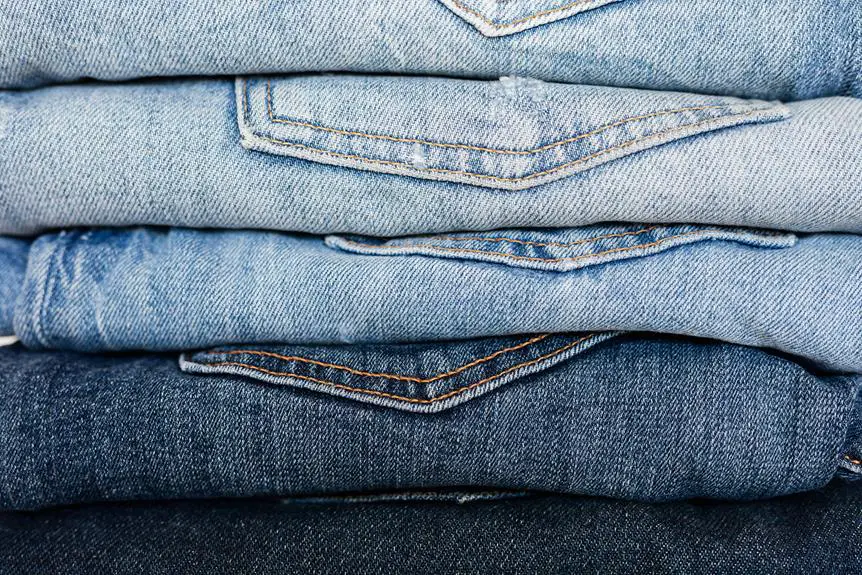When you're choosing between poplin and broadcloth, it's important to recognize how each fabric serves different purposes. Poplin's lightweight, smooth feel makes it a go-to for casual wear, while broadcloth's heavier, tightly woven structure lends itself well to formal attire. You might think the decision is straightforward, but factors like durability and drape can complicate things. So, which fabric truly fits your needs, and what should you consider before making your choice? Understanding these nuances can make all the difference in your wardrobe.
Table of Contents
Key Takeaways
- Poplin is lightweight with a smooth texture, while broadcloth is heavier and has a pronounced texture suitable for formal attire.
- Poplin offers a crisp, clean look ideal for casual wear, whereas broadcloth provides a polished appearance for tailored garments.
- Poplin is generally more durable and wear-resistant than broadcloth, which may show signs of wear more quickly.
- Common uses for poplin include shirts and dresses, while broadcloth excels in formal wear and upscale table linens.
Overview of Poplin
Poplin is a lightweight fabric known for its smooth texture and versatile applications in clothing and home textiles. You'll find it commonly used in shirts, dresses, and even table linens. The fabric's tight weave gives it a crisp, clean look, making it a popular choice for both formal and casual wear. Its breathability ensures comfort, especially in warmer weather, allowing you to stay cool while looking polished.
When you touch poplin, you'll notice its soft feel, which enhances its appeal for everyday clothing. It's typically made from cotton or a cotton blend, but you might also encounter variations with synthetic fibers for added durability and wrinkle resistance. This versatility means you can dress it up or down depending on the occasion.
Caring for poplin is relatively easy—most varieties are machine-washable, so you won't have to stress about maintenance. Whether you're wearing a tailored poplin shirt to the office or lounging in a poplin dress, you'll appreciate its lightweight nature and stylish appearance.
Poplin truly stands out as a staple fabric, making it an essential addition to any wardrobe.
Overview of Broadcloth
Broadcloth is a tightly woven fabric that offers a smooth finish and is often used for dress shirts, blouses, and other formal attire. Known for its durability, broadcloth provides a crisp appearance that enhances your overall look. You'll typically find it made from cotton or a cotton blend, which adds to its comfort and breathability, making it a popular choice for both warm and cool weather.
When you wear broadcloth, you'll appreciate how well it holds its shape, giving you a polished appearance throughout the day. The fabric's tight weave contributes to its resistance to wrinkles, so you won't have to worry about constant ironing. Broadcloth is also available in various colors and patterns, allowing you to express your personal style without sacrificing professionalism.
Another benefit is that broadcloth tends to be more affordable than some other fabrics, making it an excellent option for those building a versatile wardrobe. Whether you're dressing for a meeting, a formal event, or a casual outing, broadcloth can adapt to your needs, providing both style and function.
Key Differences in Texture
When you compare poplin and broadcloth, you'll notice distinct differences in their weave structures that affect their overall texture.
Poplin has a finer, tighter weave, giving it a smooth feel, while broadcloth tends to be heavier and has a more pronounced texture.
Understanding these nuances can help you choose the right fabric for your needs.
Weave Structure Comparison
The weave structure of poplin and broadcloth creates distinct textures that influence their feel and appearance.
Poplin features a fine, tightly woven fabric with a slightly ribbed texture. This unique construction results in a lightweight and smooth surface, making it an excellent choice for shirts and dresses. You'll find poplin to be crisp, providing a clean look while maintaining a bit of structure.
On the other hand, broadcloth is characterized by a more pronounced, plain weave. Its texture is typically softer and denser compared to poplin. This weaving technique involves using finer threads in both the warp and weft, which gives broadcloth a flatter, more uniform surface. As a result, broadcloth drapes beautifully, making it ideal for tailored garments.
Surface Feel Differences
While both fabrics have unique weave structures, their surface feels differ significantly, impacting how they're worn and perceived.
Poplin, with its fine, smooth finish, feels soft against your skin. Its lightweight texture makes it comfortable for everyday wear, especially in warmer climates. When you touch it, you'll notice a slight crispness that adds to its refined appearance, making it a popular choice for dress shirts and blouses.
On the other hand, broadcloth offers a denser, more matte surface. It has a heavier weight and a smoother texture, but you may find it less breathable than poplin. The finish feels slightly more substantial, giving a polished look that works well for formal attire. If you're looking for a fabric that drapes nicely while still providing structure, broadcloth might be your go-to.
Ultimately, your choice between poplin and broadcloth will depend on your comfort and style preferences. If you want something lightweight and breathable, poplin's your best bet. If you prefer a more structured, polished feel, then broadcloth should be your fabric of choice.
Weight and Durability Comparison
Poplin tends to weigh a bit more than broadcloth, making it generally more durable and resistant to wear and tear. The added weight of poplin gives it a sturdier feel, making it a reliable option for items that undergo daily use, such as shirts or dresses.
On the other hand, broadcloth is lighter and may not hold up as well under heavy use. While it's still a decent choice for various garments, you might notice that it shows signs of wear more quickly compared to poplin. This difference in weight can impact how each fabric drapes and fits, too. If you prefer a fabric that maintains its shape and structure over time, poplin might be your go-to.
Ultimately, your choice will depend on your specific needs. If durability and a substantial feel are priorities, poplin will serve you well. However, if you're looking for something lightweight and crisp for less demanding applications, broadcloth could be just right.
Always weigh the pros and cons based on your intended use to make an informed decision.
Common Uses for Each Fabric
Choosing between poplin and broadcloth often comes down to their specific uses in fashion and home textiles.
Poplin is your go-to for lightweight clothing like shirts, blouses, and dresses. Its crisp texture and smooth finish make it perfect for casual and semi-formal wear. You'll find poplin widely used in everyday shirts, offering breathability and comfort, especially in warmer weather.
On the other hand, broadcloth shines in formal wear and tailored garments. Thanks to its slightly heavier weight and tighter weave, broadcloth provides a polished look, making it ideal for suits and formal shirts. You might notice broadcloth in dress shirts and blazers, where a structured appearance is essential.
In the realm of home textiles, poplin often features in curtains and bed linens due to its softness and vibrant colors. Broadcloth, with its upscale feel, works well for tablecloths and upholstery, enhancing elegant settings.
Ultimately, your choice between these fabrics should align with the specific function you need, whether it's casual comfort or formal sophistication.
Care and Maintenance Tips
Understanding how to care for poplin and broadcloth will help maintain their quality and appearance over time. Both fabrics require specific attention, but following these tips will ensure your garments stay looking their best.
| Care Tips | Poplin & Broadcloth |
|---|---|
| Washing | Use cold water to prevent shrinkage. |
| Drying | Air dry when possible; avoid high heat. |
| Ironing | Iron on medium heat; use steam for wrinkles. |
| Storing | Hang or fold neatly to avoid creases. |
| Stain Treatment | Treat stains promptly with mild detergent. |
Frequently Asked Questions
Can Poplin and Broadcloth Be Used Interchangeably in Sewing Projects?
You can't always use poplin and broadcloth interchangeably in sewing projects. Each fabric has unique characteristics, affecting the drape and finish. It's best to consider your project's requirements before choosing between the two.
What Are the Historical Origins of Poplin and Broadcloth Fabrics?
You'll find that poplin originated in France during the 15th century, while broadcloth dates back to medieval England. Both fabrics evolved through time, shaped by different cultures and needs, offering unique characteristics for various uses.
Are There Eco-Friendly Options for Poplin and Broadcloth Fabrics?
Yes, you can find eco-friendly options for both fabrics. Look for organic cotton or recycled materials, which reduce environmental impact. Many brands now prioritize sustainability, so check labels and certifications for greener choices.
How Do Poplin and Broadcloth Compare in Terms of Breathability?
When comparing breathability, poplin's lightweight weave allows for better airflow, making it more suitable for warm weather. Broadcloth, while still breathable, tends to be denser and less airy, which may not be ideal for hot climates.
What Colors and Patterns Are Popular for Poplin and Broadcloth Fabrics?
Popular colors for both fabrics include classic whites, blues, and pastels, while patterns like stripes and checks stand out. You'll find vibrant prints in poplin, and subtle, elegant designs in broadcloth, perfect for various styles.
- The Use of Nonwovens in Construction and Civil Engineering - July 11, 2025
- The Use of Nonwovens in Construction and Civil Engineering - July 11, 2025
- The Use of Nonwovens in Construction and Civil Engineering - July 11, 2025







